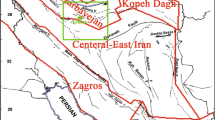Abstract
Fuzzy sets are employed as a key tool in order to estimate strength parameters of soil. The strength parameters of geological formations can vary widely from one location to another, and definite values for strength parameters cannot be assigned to each formation. So, the fuzzy set can solve the problem by assigning a series of values to the parameters. The ultimate aim of this estimation is seismic–landslide hazard zonation using Jibson et al. (Eng Geol 57:271–289, 2000) method. The quadrangle of Tootkabon is selected for evaluating the ability of this method to predict the location of landslide occurred during 1990 Manjil earthquake (Mw = 7.3). Using a complete inventory map of the landslides occurred during the Manjil earthquake; the accuracy of the prepared seismic–landslide hazard zonation map and related strength parameters have been evaluated.
Access this chapter
Tax calculation will be finalised at checkout
Purchases are for personal use only
Similar content being viewed by others
References
Alvarez Grima M (2000) Neuro-Fuzzy modeling in engineering geology. A.A. Balkema, Rotterdam, p 244
Berkan RC, Trubatch SL (1997) Fuzzy system design principles, building fuzzy if-then rule bases. The institute of Electrical and Electronics Engineering, Inc., New York, p 496
Gee MD (1992) Classification of landslide hazard zonation methods and a test of predictive capability. In: Proceedings of 6th international symposium on landslides, Christchurch, New Zealand, pp 947–952
Goodman RE (1995) The 35th Rankine Lecture-Bloch theory and its application, Ge’technique, 45:381-423
Jibson RW (1993). Predicting earthquake-induced landslide displacement using Newmark’s sliding block analysis. Transportation Research Record 1411, pp 9–17
Jibson RW, Harp EL, Michael JA (1998) A method for producing digital probabilistic seismic landslide hazard maps: an example from the Los Angeles, California, area, U.S. Geological Survey, Open-File Report, pp 98–113
Jibson RW, Harp EL, Michael JA (2000) A Method for Producing Digital Probabilistic Seismic Landslide Hazard Maps. Eng Geol 57:271–289
Juang CH, Jhi YY, Lee DH (1998) Stability analysis of existing slopes considering uncertainty. Eng Geol 49:111–122
Mahdavifar M, Jafari MK, Zolfaghari MR (2007) The attenuation of arias intensity in Alborz and Central Iran. International institute of earthquake engineering and seismology (IIEES), Tehran, pp 1–8
Mahdavifar M, Jafari MK, Zolfaghari MR (2008) Real-time generation of arias intensity and seismic landslides hazards maps using GIS. JSEE 10:81–89
Newmark NM (1965) Effects of earthquakes on dams and embankments. Geotechnique 15:139–160
Sonmez H, Gokceoglu C, Ulusay R (2003) An application of fuzzy sets to the geological strength index (GSI) system used in rock engineering. Eng Appl Artif Intell 16:251–269
Sonmez H, Gokceoglu C, Ulusay R (2004) A mamdani fuzzy inference system for the geological strength index (GSI) and its use in slope stability assessment. Int J Rock Mech Min Sci 41:1–6
Zadeh LA (1965) Fuzzy sets. Inf Control 8:338–353
Author information
Authors and Affiliations
Corresponding author
Editor information
Editors and Affiliations
Rights and permissions
Copyright information
© 2013 Springer-Verlag Berlin Heidelberg
About this paper
Cite this paper
Majidi, R.F., Mahdavifar, M.R., Kashanchi, M. (2013). Estimating the Strength Parameters of Geological Formations Using Fuzzy Sets and its Application in Generating Seismic–Landslide Hazard Maps. In: Ugai, K., Yagi, H., Wakai, A. (eds) Earthquake-Induced Landslides. Springer, Berlin, Heidelberg. https://doi.org/10.1007/978-3-642-32238-9_88
Download citation
DOI: https://doi.org/10.1007/978-3-642-32238-9_88
Published:
Publisher Name: Springer, Berlin, Heidelberg
Print ISBN: 978-3-642-32237-2
Online ISBN: 978-3-642-32238-9
eBook Packages: Earth and Environmental ScienceEarth and Environmental Science (R0)




